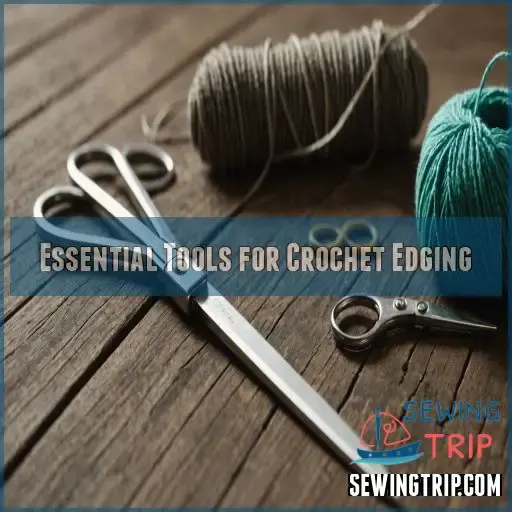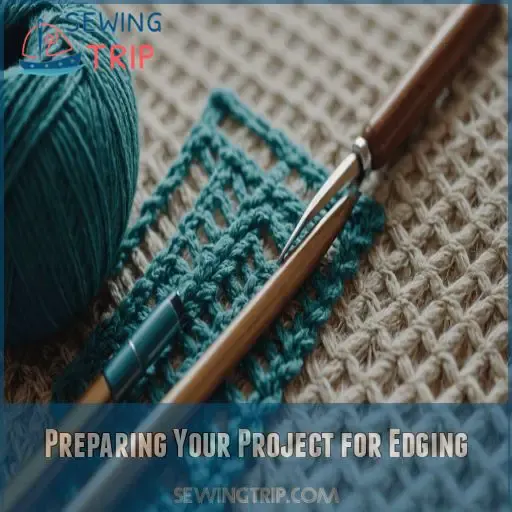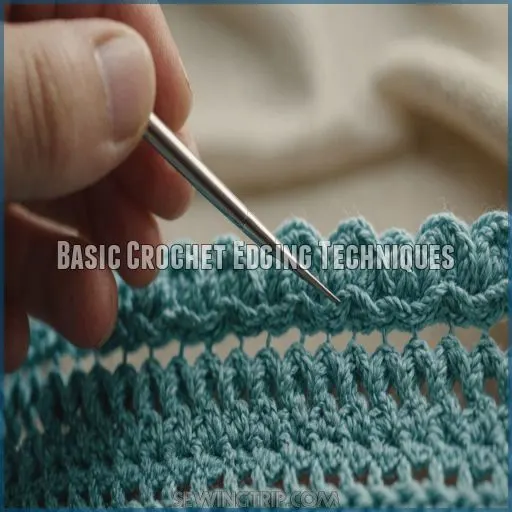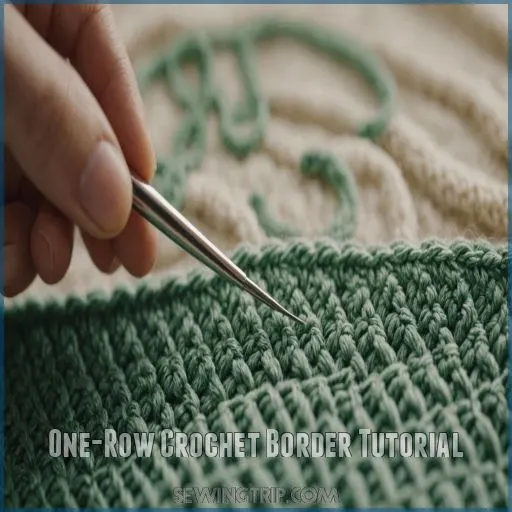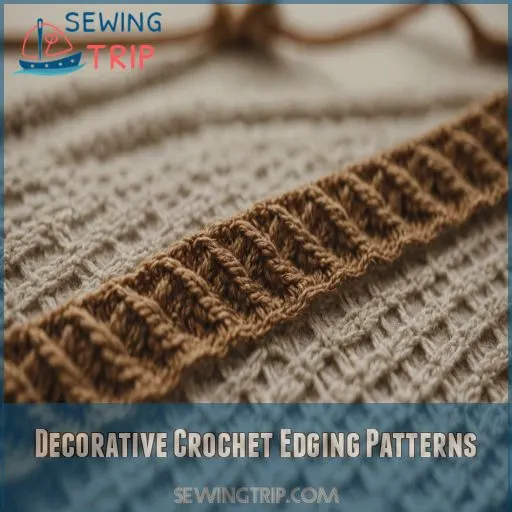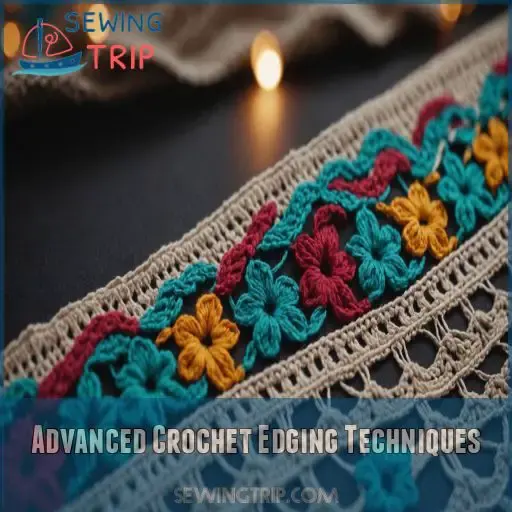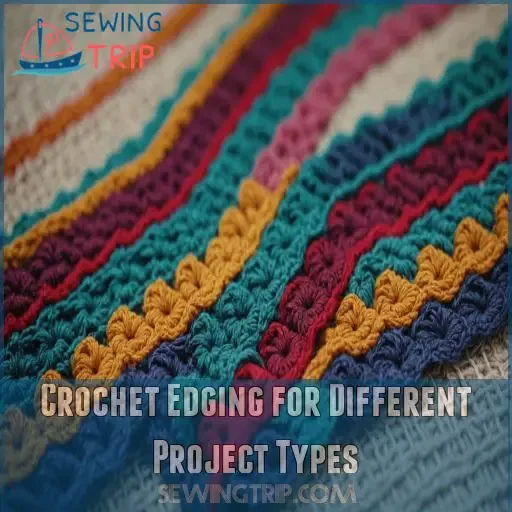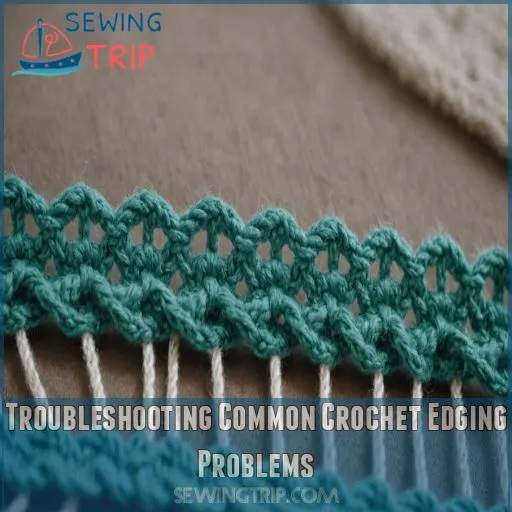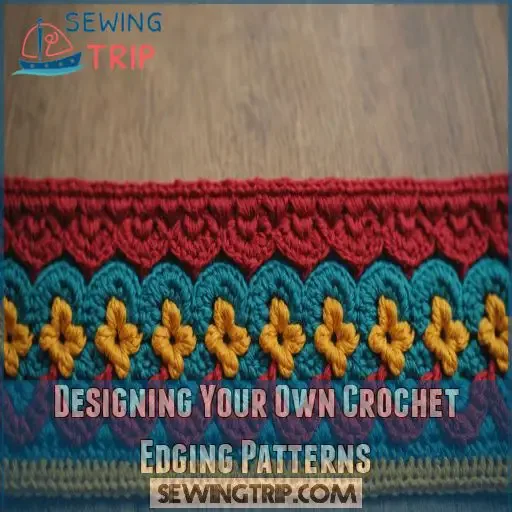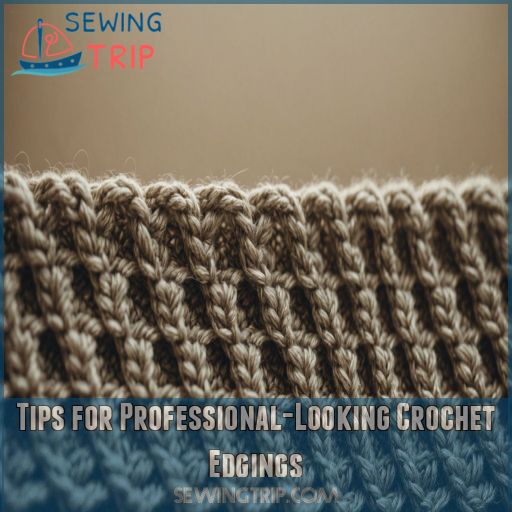This site is supported by our readers. We may earn a commission, at no cost to you, if you purchase through links.
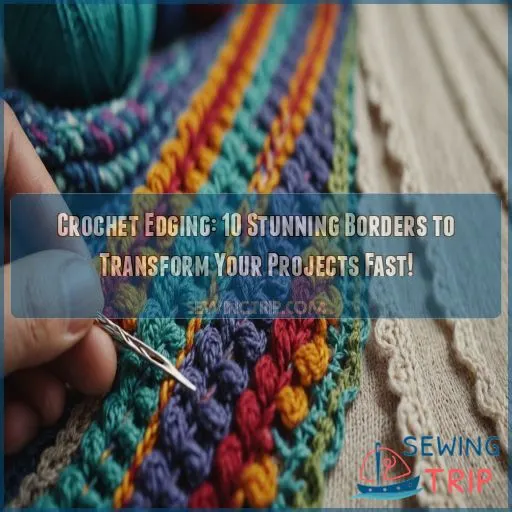 Ready to jazz up your crochet projects with some fab edging? Grab your hooks, yarn, and a splash of creativity!
Ready to jazz up your crochet projects with some fab edging? Grab your hooks, yarn, and a splash of creativity!
Choosing the right crochet edging can instantly transform even the simplest piece into a masterpiece.
From the humble single crochet border to snazzy decorative patterns like shell or picot, your options are endless.
A stitch marker, scissors, and a tapestry needle make your life a whole lot easier, trust me.
So, why settle for plain when you can have stunning?
Let’s explore crochet edgings that will knock your socks off!
Table Of Contents
- Key Takeaways
- Essential Tools for Crochet Edging
- Preparing Your Project for Edging
- Basic Crochet Edging Techniques
- One-Row Crochet Border Tutorial
- Decorative Crochet Edging Patterns
- Advanced Crochet Edging Techniques
- Crochet Edging for Different Project Types
- Troubleshooting Common Crochet Edging Problems
- Designing Your Own Crochet Edging Patterns
- Tips for Professional-Looking Crochet Edgings
- Frequently Asked Questions (FAQs)
- Conclusion
Key Takeaways
- You’re jazzing up your crochet projects with the perfect edgings, turning even simple creations into masterpieces, and you’re ready to take your work to the next level by learning about blocking. Think of edgings as the sprinkles on your ice cream – they’re not essential, but they certainly make things exciting.
- Want pro-level crochet edges? Remember, tools are your best buddies: select the right hook and yarn, and keep stitch markers, sharp scissors, and a trusty tapestry needle close by for weaving in those pesky ends. They’re like your backstage crew, quietly making sure everything runs smoothly.
- Struggling with uneven edges or ruffling? Don’t fret. It’s all about maintaining even tension, counting your stitches carefully, and occasionally blocking your piece to achieve a salon-like freshness. You’ll be fixing those quirks in no time with some stitch TLC.
- Get your creative juices flowing by experimenting with various edging patterns, such as picot, shell, or zig-zag. Mixing colors or adding beads can elevate your project from cozy to Instagram-worthy – your projects will be the talk of the crochet town.
Essential Tools for Crochet Edging
You’re about to start a crochet edging adventure, but first, let’s make sure you’ve got the right tools for the job.
From selecting the perfect hook to choosing yarn that complements your project, we’ll cover all the essentials you’ll need to create stunning borders that’ll make your crochet pieces pop.
Choosing the Right Crochet Hook
For crochet edging, choosing the right hook is key.
Your hook should match:
- Your yarn weight
- Your project’s size
- Your personal stitch tension
Consider hook material for comfort during long sessions.
Selecting Appropriate Yarn
You’ve picked your hook, now let’s talk yarn! The right choice can make or break your edging. Consider yarn weight, fiber content, and color to elevate your project’s finish.
Stitch Markers and Scissors
Every crocheter knows the frustration of losing track of stitches. That’s where stitch markers and scissors come in handy.
These tiny tools make a big difference:
- Stitch markers keep you on track
- Sharp scissors make for clean cuts
- Both save time and headaches
Tapestry Needle for Weaving Ends
Along with markers and scissors, don’t forget your trusty tapestry needle! This slender sidekick helps you weave in those pesky loose ends, giving your crochet edging a polished, professional finish.
Preparing Your Project for Edging
Before you add that beautiful border to your crochet project, you’ll need to prep it properly.
Let’s explore how to block your piece, count and mark your stitches, and create an even foundation round that’ll set you up for edging success.
Blocking Your Crochet Piece
Why should you block your crochet piece before adding an edging? It’s like giving your project a spa day! Blocking evens out stitches, smooths edges, and sets the shape.
You’ll have a crisp canvas for that stunning border you’re planning.
Counting and Marking Stitches
Stitch counting and marking is important for getting perfect edges. Here’s what you need to know:
- Use removable stitch markers for easy adjustments
- Count in groups of 10 for larger projects
- Mark color changes or pattern repeats
- Place markers at corners for even distribution
- Try safety pins as budget-friendly markers
Creating an Even Foundation Round
Success in crochet edging hinges on a solid foundation.
Start by working a round of single crochet along your project’s edges.
Keep your tension even and adjust your hook size if needed.
You’re building the canvas for your border masterpiece!
Basic Crochet Edging Techniques
You’re about to discover four essential crochet edging techniques that’ll elevate your projects from good to gorgeous.
These basic borders – single crochet, double crochet, slip stitch, and reverse single crochet (also known as the crab stitch) – are your secret weapons for adding a polished finish to any crochet creation.
Single Crochet Border
You’ve prepped your project, now let’s jazz it up! The single crochet border is your go-to for a clean, polished look. Here’s why it’s a crowd-pleaser:
- Versatile: Works on blankets, hats, scarves, and amigurumi
- Beginner-friendly: Simple, repetitive stitch
- Customizable: Easy to add multiple rounds for thickness
- Sturdy: Provides structure and durability to your project
Double Crochet Border
A double crochet border adds height and drama to your project’s edge. It’s a versatile stitch that works well with various yarn weights and allows for easy colorwork incorporation.
Slip Stitch Border
The humble slip stitch border, like a whisper in yarn, adds a subtle elegance to your crochet projects.
This versatile edging technique offers:
- Clean, streamlined finish
- Minimal bulk for layering
- Quick and easy application
- Ideal for delicate items
Reverse Single Crochet (Crab Stitch) Border
While it may seem tricky at first, the reverse single crochet (crab stitch) border adds a unique twist to your projects.
You’ll work backwards, creating a rope-like edge that’s both sturdy and eye-catching.
One-Row Crochet Border Tutorial
You’ll love how a one-row crochet border can instantly elevate your projects with minimal effort.
In this tutorial, we’ll walk you through the steps to create a stunning edge that’ll make your fellow crafters green with envy.
Step-by-Step Instructions for One-Row Border
Ready to level up your crochet game? Let’s tackle the one-row border! This nifty technique will have you adding flair to your projects faster than you can say "yarn over.
Tips for Maintaining Even Tension
Maintaining even tension is key to a flawless one-row border. Hook size and yarn choice matter.
Practice these tips:
- Use the right crochet supplies
- Practice consistent pressure
- Check tension gauge
Troubleshooting Common Issues
Struggling with uneven edges, tension issues, or curling? Fear not! Those tricky spots need a stitch fix. Here’s a handy table to tackle common crochet edging woes:
| Problem | Cause | Solution |
|---|---|---|
| Uneven edges | Inconsistent tension | Practice and adjust tension |
| Incorrect stitch count | Miscounting stitches | Re-count and adjust |
| Curling edges | Too tight/stiff stitches | Relax tension, adjust hook |
| Ruffled edges | Extra stitches | Reduce stitches appropriately |
Uneven edges can be caused by inconsistent tension.
Incorrect stitch count can result from miscounting stitches.
Curling edges are often caused by too tight/stiff stitches.
Ruffled edges can occur due to extra stitches.
Adapting the One-Row Border for Different Projects
Transform those blanket borders or garment trims with a one-row crochet border.
Whether you’re jazzing up scarf edges or home decor, try these techniques:
- Adjust tension.
- Use contrasting colors.
- Vary stitch heights.
Decorative Crochet Edging Patterns
Elevate your crochet projects with a touch of decorative flair!
From the classic shell or scallop border to the whimsical zig-zag pattern, these stunning edging techniques will transform your work in no time.
Shell or Scallop Border
Imagine your project wearing a crown! Crocheting a shell or scallop border adds elegance and mastery to your project with texture and charm.
| Shell Stitch Variations | Scallop Border Sizes |
|---|---|
| Multiple sizes | Versatile on shapes |
| Textured beauty | Easy colorwork |
| Customizable | Beginner-friendly |
| Triangle stitch option | Enhances edges |
| Detailed crochet tutorials | Adds flair to any project |
Shell stitch variations offer a variety of sizes and options.
Scallop border sizes are versatile and can be used on any shape.
Shell stitch variations can be customized to your liking.
Scallop border sizes are beginner-friendly.
Shell stitch variations can be used to create textured beauty.
Scallop border sizes allow for easy colorwork.
Shell stitch variations include the triangle stitch option.
Scallop border sizes enhance edges and add flair to any project.
Detailed crochet tutorials are available for both shell stitch variations and scallop border sizes.
Picot Border
After trying scallop borders, give the picot border a go! It adds flair to your crochet projects, adjusting placement and size effortlessly.
Zig-Zag Border
Speaking of borders, the Zig-Zag Border works wonders. Try it with:
- Zig-zag variations
- Colorwork edging techniques
- Fun texture effects
You’ll impress your crochet group!
Puff Stitch Border
Puff stitch borders add a plush, dimensional touch. Experiment with yarn weight, stitch size, and placement to suit your crochet project’s style and scale.
Triangle Border
Ready for some triangle border fun? Liven up your projects with crocheting triangles. Try these patterns:
- Drop Stitch
- Beginner Triangle Borders
- Crochet Potholder Styles
- Triangle Border Variations
Advanced Crochet Edging Techniques
Ready to take your crochet projects to the next level?
Explore new techniques like around the post HDC clusters and colorful lace edgings.
These techniques will make your friends beg for your secrets and your fingers a little bit fancy.
Around the Post HDC Clusters
Add a punch of texture to your projects with around the post HDC clusters.
Experiment with hdc cluster variations, colorwork clusters, and unique cluster placements to create interesting cluster stitch combos and fabulous drape.
Slip Stitch and Drop Stitch Border
The slip stitch and drop stitch border adds a cool texture to your crochet projects.
Experiment with stitch counts and yarn choices to create your desired effect.
Try it on blankets, shawls, or even garments for a unique finish.
- Versatile stitch pattern
- Adjustable for various stitch counts
- Yarn choice impacts final texture
- Elevates a range of crochet projects
Lace Edging Patterns
Shifting gears, lace edging brings delicate charm to your projects. Picture airy, vintage lace patterns with ornate motifs. Lace edging charts guide you in creating stunningly detailed borders.
Colorwork in Crochet Borders
With colorwork techniques, you can transform crochet borders into vibrant masterpieces. Try stripe patterns, gradient borders, or mosaic crochet. Intarsia borders add flair and elevate your project to new heights!
Crochet Edging for Different Project Types
Adding the perfect edge to your crochet projects is like finding the right cherry for your sundae—a small touch that makes a big difference!
Whether you’re dressing up a cozy blanket, a stylish sweater, or elegant home decor, the right edging will elevate your crocheted creations to new heights.
Blanket and Afghan Edging
Blanket and afghan edging lets you add a pop of color, texture, or intricate stitches to cozy projects. Play with fringe, corners, and creative colorwork for a custom look.
Garment Edging (Sweaters, Cardigans)
Adding stylish edges to your sweaters and cardigans can elevate them from drab to fab in no time.
Explore these sweater edging ideas and cardigan border styles:
- Play with texture and color.
- Pick matching yarn choices.
- Find edging for different knits.
- Experiment with lace trims.
- Try contrasting borders for flair.
Accessory Edging (Scarves, Shawls)
When crafting scarf edging styles or exploring shawl border ideas, consider how yarn choice impacts the edging tension. Remember, a perfectly blocked accessory can be the cherry on top!
Home Decor Item Edging (Pillows, Tablecloths)
Dream of sprucing up your pillows and tablecloths with delightful crochet edging? Try these ideas and transform your decor with creative flair for a homey touch:
- Lace Elegance
- Bold Scallops
- Whimsical Waves
- Classic Shells
- Modern Zig-Zag
Troubleshooting Common Crochet Edging Problems
Crochet edging can be tricky, but don’t worry – we’ve got your back!
In this section, we’ll tackle common issues like uneven edges, stitch count problems, and tension troubles,
giving you the tools to create polished, professional-looking borders every time.
Fixing Uneven Edges
If your crochet edges look like a toddler’s doodle, fret not! Focus on stitch counting and seam corrections. Use blocking techniques to ease tension.
Here’s a helpful table below:
| Issue | Solution | Tools Needed |
|---|---|---|
| Uneven Edges | Block and reshape | Blocking mats |
| Loose Seams | Reinforce stitching | Tapestry needle |
| Tight Tension | Loosen your grip | Comfortable hook |
| Rough Finish | Soften with washing | Gentle detergent |
Use blocking techniques to ease tension.
Adjusting Stitch Count for Even Borders
Balancing stitch counts for even rows can feel like solving a puzzle! Try these steps:
- Double-check stitch multiples align.
- Adjust foundation rounds.
- Use stitch substitutions for symmetry.
Dealing With Curling or Ruffling Edges
Curling edges got you in a twist? Blocking can work wonders, especially with lightweight yarns. Consider project weight, fabric type, and stitch tension for a ripple-free, sleek finish.
Correcting Tension Issues in Borders
Struggling with uneven tension in your crochet borders?
Try adjusting your hook size, yarn choice, and blocking techniques.
With a bit of practice, you’ll nail those smooth, professional-looking edges in no time!
Designing Your Own Crochet Edging Patterns
Express your creative side by designing crochet edging patterns that showcase your individuality and style, learning about different crochet border styles.
It’s as easy as mixing basic stitches, adding a splash of color, and charting your visions—who knew crochet could be your personal art gallery?
Combining Basic Stitches for Unique Borders
Ever tried blending basic stitches to create a unique border?
You’re not alone! Mixing textures and shapes in your crochet projects can work wonders.
Give combining stitch patterns a whirl—you’ll love the creative control and personal flair it adds!
Incorporating Texture and Color
Infuse life into your crochet projects with color gradients and textured stitches!
Ever try experimenting with yarn weight or color blocking?
Stitch combinations are like jazz—freedom to create endless visuals without missing a beat.
Add that zing to your masterpiece!
Charting and Diagramming Custom Edgings
Charting and diagramming custom edgings allow you to visualize your crochet border ideas.
Grab some graph paper and sketch out stitch patterns, color codes, and edge types to bring your unique designs to life.
Tips for Professional-Looking Crochet Edgings
Transform your crochet pieces from homemade to professional with a few savvy edging tricks.
You’ll have edges so straight and neat that even your pickiest friends might ask which high-end boutique you bought it from!
Achieving Straight and Even Edges
To achieve straight and even edges, focus on tension control.
Keep your stitch count consistent.
Use the right hook size.
Block your work for perfect row alignment.
Can’t stress enough!
Seamlessly Joining the Beginning and End
Joining ends seamlessly can feel like magic. Use an invisible join or slip stitch for a neat finish. Hide yarn tails behind single crochet stitches, and voilà! Perfect edge.
Blocking and Finishing Techniques
Blocking and finishing are key – use the right tools like a steam iron or spray bottle for a professional look.
Weave in ends neatly, and care for your project properly.
Enhancing Projects With Contrasting Edgings
After blocking, let’s add punch with contrasting edgings! Mix colors and textures by choosing a yarn weight that complements your project’s shape and edging style. Your piece’ll shine beautifully!
Frequently Asked Questions (FAQs)
What is the best stitch for edging in crochet?
For a polished crochet edge, try the single crochet border—it’s a versatile “little black dress” of stitches.
It suits any project without requiring math and adds a clean, classic finish.
Stitch your way to perfection!
How to crochet a simple edge?
Ever tried crocheting a simple edge?
It’s like putting the cherry on your yarn sundae.
Start with single crochet all around.
Add a flair with a crab stitch or a charming picot for that elegant touch.
How do you get a nice edge when crocheting?
Give your crochet project a polished finish by adding a border.
Start with a foundation round, use a simple stitch like a one-row border, and keep the edges even.
You’ll have a masterpiece in no time!
How do you crochet a scalloped edge for beginners?
You’re on the hook for adding some flair!
Crochet scalloped edges with ease: single crochet all around, then skip one stitch and double crochet five in the next.
Repeat, and you’ll scallop your way to elegance.
Enjoy!
What yarn weight is best for crochet edging?
When crocheting an edge, medium (worsted weight) yarn works beautifully, providing balance between durability and detail.
If you’re feeling adventurous, thinner yarns add elegance, while chunky yarn makes for a bold and cozy finish.
How do I prevent wavy or uneven crochet edging?
Prevent wavy crochet edging by maintaining even tension and using the right hook size.
Imagine you’re Goldilocks—don’t crochet too tightly or loosely!
Plus, make sure the stitch count evenly matches each row for a smooth finish.
Can I add beads or sequins to crochet edging?
Imagine your crochet pieces shining like a knight’s armor!
You can absolutely add beads or sequins to your edging by stringing them onto your yarn first.
Just don’t let them overshadow your crochet masterpiece.
Happy crafting!
How do I crochet edging on curved or irregular shapes?
Crocheting edging on curved or irregular shapes is like dancing with a twist.
Use flexible stitches like single crochet or slip stitches, and adjust tension to make sure the edge lays flat without puckering—just go with the flow!
What are some creative ideas for customizing crochet edging?
Jazz up crochet edging by mixing contrasting colors, using variegated yarn, or adding beads for sparkle.
Play with stitch patterns like picot or shell for texture.
Don’t limit yourself—experiment until it feels just right!
Conclusion
With a sprinkle of creativity and a dash of crochet know-how, the possibilities for stunning crochet edgings are endless.
From classic single crochet to decorative shell and picot patterns, these tutorials will have your projects looking polished and professional in no time.
So, why settle for plain when you can jazz up your crochet with these fabulous crochet edging techniques?
Get ready to transform your projects and wow everyone with your crochet edging mastery!

